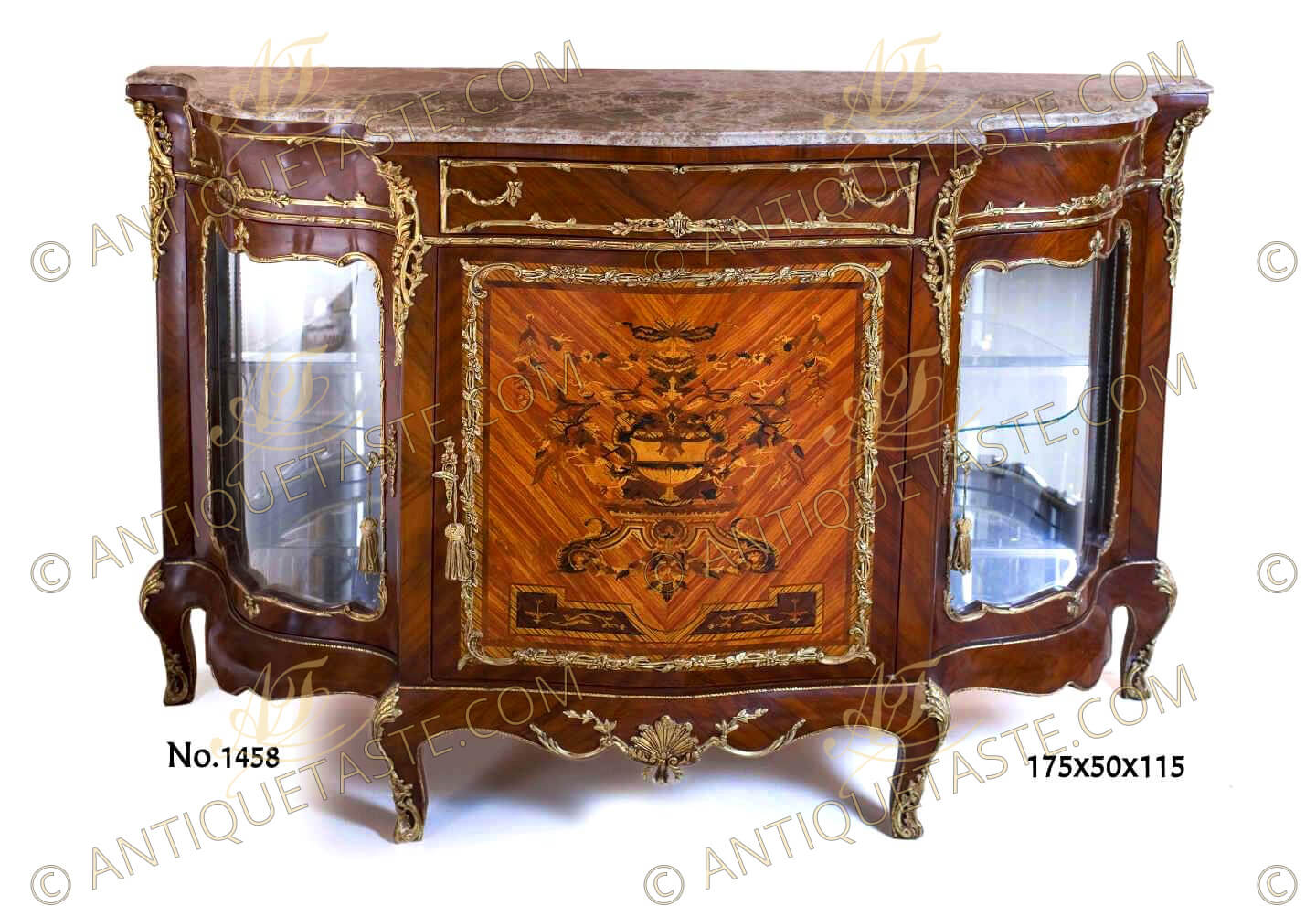Ref#C-1458 | Description
A fine French Napoléon III Louis XV Revival style ormolu mounted veneer and marquetry inlaid serpentine shaped breakfront display cabinet, after the model by Henri Picard,
The marble top above a frieze drawer mounted with ormolu encadrement and flanked to each side by two faux drawers bordered with foliate ormolu separated by pierced ormolu acanthus chutes, all surmounting three cupboard doors,
The central marquetry sans traverse veneer decorated door enriched with fine chiseled foliate ormolu frame and amidst two curved mirrored display glass doors, all applied with ormolu keyhole escutcheons,
The lower arbalest shape frieze is raised on four short cabriole legs adorned with ormolu strap-works, acanthus leaves, shell and ormolu pierced sabots.
Ref#C-1458
175 x 50 x 115cm
The Napoleon III style:
The Napoleon III style is the name commonly given to a 19th-century style of Renaissance Revival architecture in France, especially in Paris. It is a sub-style of Second Empire architecture, which is a term also used elsewhere in the world for this style. It is characterized by its eclecticism, because of the mix of decorative elements from the past. It flourished during the Second French Empire, with the patronage of Napoleon III.
The term "Napoleon III style" (French: style Napoléon III) may be contemporary: legend has it that when the Empress Eugénie asked architect Charles Garnier whether the Palais Garnier, under construction in 1862, would be built in the Greek or Roman style, he replied, "It is in the Napoleon III style, Madame!" The term is also not reserved exclusively for architecture. It is used also to describe furniture of the period, especially in the marketplace, where other "royal period" styles are commonplace.
The style is characterised by high façades, mansard roofs, and, more rarely, pavilions. The buildings are richly decorated but with clearly defined outlines. The Napoleon III style is associated with the renovation of Paris under Baron Haussmann between 1852 and 1870. The buildings of the renovation show a singularity of purpose and design, a consistency of urban planning that was unusual for the period. Numerous public edifices: railway stations, the tribunal de commerce, and the Palais Garnier were constructed in the style.
Henri Picard
Henri Picard worked in Paris from 1831 to 1884, most notably for the Emperor Napoléon III. He was based in Paris at 6, rue Jarente from 1831 to 1839, before moving to 10, rue de la Perle. The firm was active until around 1890.
Celebrated for the high quality of his production, Henri Picard supplied many important patrons, including garnitures and table pieces for the petits appartements of Emperor Napoléon III at the Louvre. An important pair of twelve-light candelabra by Picard remain in the Musée du Louvre today.(Mestdagh, Camille & Lécoules, Peter, L'Ameublement d'Art Français)
Tags
- #Napoleon_III_Display_Cabinet | #Henri_Picard_Cabinet | #Louis_XV_Revival_Display_Cabinet | #Napoleon-III-China_Sideboard | #Napoleon-III-Credenza | #Second-Empire-Napoleon-III-Sideboard | #Ormolu-mounted-Napoleon-III-style-Credenza | #French-Louis XVI-Sideboard | #Parquetry-and-Marquetry-Bahut | #French-Bahut | #Japanese-lacquer-and-ebony-Sideboard | #Japanese-Black-small-Buffet | #Jean-Henri-Riesener-Bahut | #Empire-Style-Cabinet | #Napoleon-Style-Sideboard | #Napoleon-Second-Empire-Furniture | #Francois-Linke-Display-Cabinet | #Leon-Message-ormolu-design | #Haentges-Frères-Commode | #French-style-Cartonnier | #French-style-Cupboard | #French-Bombe-Commode | #19th Century Transitional style Commode | #Jean-François Leleu Commode | #Napoleon III Commode | #Napoleon III style Cabinet | #Napoleon III Side Cabinet | #Napoleon III Sideboard | #Meuble A Hauteaur D'appui | #Commode a vantaux | #Antoine Gaudreaux Commode | #Jean-Henri Riesener commode | #Marie-Antoinette commode | #Charles Cressent commode | #Maison Millet commode | #Pierre Antoine Foullet commode | #André Charles Boulle commode | #French style commode | #Louis XV commode | #Louis XIV commode | #Louis XVI commode

